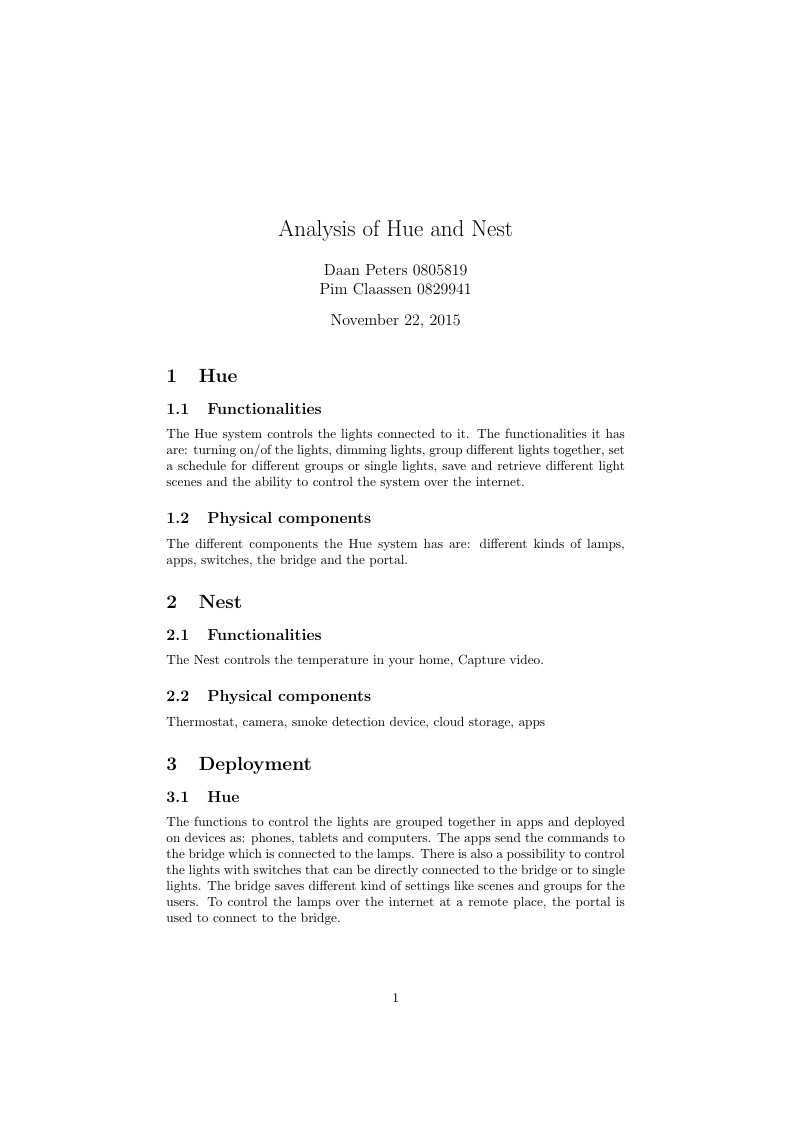
Analysis of Hue and Nest
Author:
pim
Last Updated:
há 10 anos
License:
Creative Commons CC BY 4.0
Abstract:
new version

\begin
Discover why over 20 million people worldwide trust Overleaf with their work.
new version

\begin
Discover why over 20 million people worldwide trust Overleaf with their work.
\documentclass[a4paper]{article}
\usepackage[english]{babel}
\usepackage[utf8]{inputenc}
\usepackage{amsmath}
\usepackage{graphicx}
\usepackage[colorinlistoftodos]{todonotes}
\title{Analysis of Hue and Nest }
\author{Daan Peters 0805819 \\ Pim Claassen 0829941}
\date{\today}
\begin{document}
\maketitle
\section{Hue}
\subsection{Functionalities}
The Hue system controls the lights connected to it. The functionalities it has are: turning on/of the lights, dimming lights, group different lights together, set a schedule for different groups or single lights, save and retrieve different light scenes and the ability to control the system over the internet.
\subsection{Physical components}
The different components the Hue system has are: different kinds of lamps, apps, switches, the bridge and the portal.
\section{Nest}
\subsection{Functionalities}
The Nest controls the temperature in your home, Capture video.
\subsection{Physical components}
Thermostat, camera, smoke detection device, cloud storage, apps
\section{Deployment}
\subsection{Hue}
The functions to control the lights are grouped together in apps and deployed on devices as: phones, tablets and computers. The apps send the commands to the bridge which is connected to the lamps. There is also a possibility to control the lights with switches that can be directly connected to the bridge or to single lights. The bridge saves different kind of settings like scenes and groups for the users. To control the lamps over the internet at a remote place, the portal is used to connect to the bridge.
\subsection{Nest}
\section{extra-functional properties}
\subsection{Reliability}
The Hue system is controlled via the bridge which can make this a single point of failure. It does not require the system to be connected to the internet to control the lights, only for the remote access to the system. This increases the reliability of the system. The lights work as a signal repeater which means that the range of the system can be extended by adding more lights.
\subsection{Privacy}
All the data of the system is stored in the bridge which is located at the user. The portal opens the connection to the bridge from outside. It is not clear whether only the owner can access the data or that also third parties can access this data. The portal connection has to be setup by the user, so the user can decide to open the connection. This makes the system adhere to the privacy of the user.
\subsection{Performance}
http://www.developers.meethue.com/things-you-need-know
As indicated by the Hue developer site, the Hue system has a transition time and a maximum number of commands that can be send in one second. The transition time can be set by the user. This time can be set to zero, so this would not influence the performance of the system. The maximum number of commands to send to light is about 10 per second and for groups it is 1 per second. So as long as you don't want to make a complex disco out of your lighting system, you should be fine. The system has a maximum number of lights that can connect to a single bridge which is 63, but adding more lights will make the system slower. The advised maximum is 50.
\section{Development}
Developers that want to use the Hue system can use the REST api of the bridge. All lights and groups can be set using different calls to the api. The device that makes these calls needs to be in the same network as the bridge. Philips is planning to make it accessible from the internet, but this is not yet implemented. New applications need to be added to the bridge by pressing a physical button on the bridge, this makes the system more secure because other apps can not access the system before the user adds them.
\section{Google Nest}
\subsection{Functionalities}
The Google Nest is a home automation device responsible for controlling a home's heating, and sometimes air conditioning. The smart thermostat allows the user to control the temperature of their home throughout the day using a schedule, such as setting a lower temperature at night. As they are connected to the Internet, they allow users to adjust heating settings from other internet-connected devices, such as smartphones. This allows users to easily switch off the heating or air conditioning when the house is empty. This ease of use is essential for ensuring energy savings.
\subsection{Physical components}
\subsection{Privacy}
First, to say a company takes privacy seriously makes no guarantees about what it will do with your data. It’s clear at this point that what a privacy policy says has no bearing on what the company may do tomorrow, next year, or five years from now.
Google also takes privacy seriously, but that did not stop it from consolidating its data silos or forcing Google+ into places it didn’t used to be. YouTube logins weren’t going to change under Google ownership until they did. Your most frequent contacts were your own business until Google Buzz broadcasted them to the public.
\end{document}